Reduce Your Plastic Calculator
Welcome to the Reduce Your Plastic Calculator!
Within less than 100 years, we have gone from close to 0 plastic to about 10 billion metric tons of the stuff. This is equivalent to the weight of 55,300 blue whales, which is five times more than their actual population! 🐋
In this plastic era, sometimes referred to as the Plasticene…
- About 150 million tonnes have ended up in the ocean 🌊;
- 6.5 billion metric tons in landfills 🕳️; and
- An unknown amount is inside human bodies and animals, as well as within freshwater and terrestrial environments.
Despite its detrimental impacts on the environment, plastic production has only continued to rise. In fact, by 2060, it will have increased nearly threefold.
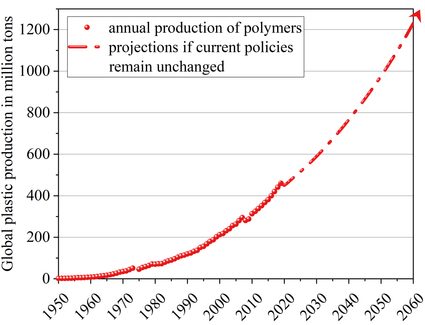
What can we do about it? Plastic pollution is a global and systemic issue, and while individual action is important, lasting change requires a multipronged approach. We need to hold corporations accountable for their plastic footprint and push for systemic changes in production, packaging, and waste management.
But that doesn’t mean we can’t make a difference! By reducing our personal plastic use, we can send a powerful message and create a collective impact. This is where our tool comes in handy!
We’ve designed our reduce your plastic calculator to help you minimize your plastic use and understand your plastic footprint. You can easily set goals and see how much plastic you’ll save over time! Keep reading to learn more about how to reduce plastic use and explore the issues of plastic pollution, its health and environmental effects, and how we can push for .
What are different types of plastic?
If we look at their chemical structure, there are uncountable plastic varieties. However, a systematic way of classifying them is based on the raw materials used to produce them and their biodegradability.
Fossil-based vs. biobased
These terms explain how the type of raw materials determines the type of plastics produced, whether from petrochemicals or biological resources.
-
Fossil-based plastics: Produced from petrochemicals like crude oil and natural gas. This category makes up 99% of all plastics today.
-
Non-biodegradable: This category includes conventional plastics like PET, PP, PE (LDPE/HDPE), and PVC, which can persist for hundreds of years. These are the most produced and most harmful types of plastics.
-
Biodegradable: These are plastics like PBAT and PCL, which are partially fossil-based and supposedly designed to biodegrade. Unfortunately, evidence suggests that in the real world, they fail to do so in a reasonable amount of time.
-
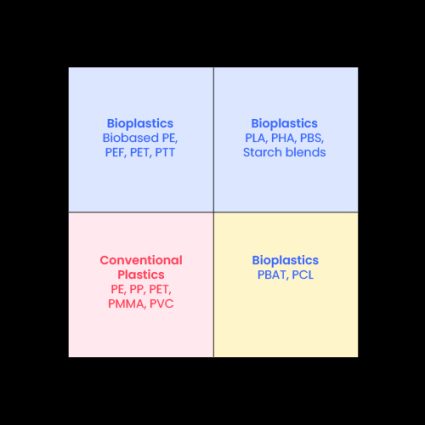
-
Biobased plastics: These are plastics that are partly or entirely made from biological feedstocks. While the biological feedstocks for bio-based plastics are often described as “renewable,” their environmental impact is highly dependent on the land-use and agricultural practices used to grow them. Most bio-based plastics also contain fossil fuel-based materials, which can in some cases make up as much as 75% of the product. These blended materials, as well as purely bio-based polymers, are frequently chemically and functionally identical to conventional plastics.
-
Biodegradable: Examples include PLA (polylactic acid) made from corn and sugarcane fermentation and other starch-based plastics like HA and PBS, which microorganisms can degrade under specific conditions. These plastics require adapted end-of-life conditions to be biodegraded.
-
Non-biodegradable: Derived from renewable resources but engineered to remain intact over time. For instance, biobased PE from sugarcane ethanol can replace conventional PE or PET, reducing dependence on fossil fuels. While their sustainable production may be possible, there are concerns that the intensive agriculture it requires could lead to deforestation.
-
Biodegradable or not?
The definition of "biodegradable" is that the material can be broken down by microorganisms and transformed into harmless natural elements like water, CO2, biomass, and so on. On this matter, it is essential to note that biobased does not necessarily mean biodegradable, and fossil-based plastics can still be biodegradable.
So remember: the fact that a given packaging mentions the word biodegradable or biocompatible does not mean that it's sustainable or that it will solve the plastic pollution problem! In reality, biodegradable end of life plastics are often not disposed of properly, contributing to even further plastic pollution.
What is the end-of-life for plastics?
Every year, corporations produce about 400 million metric tons of plastic, which are then distributed worldwide. From these plastics:
-
Nearly half (35% to 40%) are single-use and short-lived plastics like plastic bags, food packaging, and water bottles;
-
20% are dedicated to building and construction;
-
8% are related to the automotive industry;
-
6% are used in the production of electrics and electronics; and
-
The remaining is divided between other uses, such as agriculture, houseware, and more.
💡 Polyethylene and polypropylene are some of the most common types of microplastic found in the ocean. They are also the types of plastics that are primarily used in packaging and other single-use products. Perhaps this is yet another sign that we should start reducing our consumption of single-use plastics?
Once the products are used — which, in the case of single-use plastic, can be in as little time as a few seconds — the plastics are discarded.
-
Less than 9% of it is recycled;
-
12% is incinerated; and
-
All the remaining waste gets sent to landfills or ends up in our oceans, soils, and even inside us!
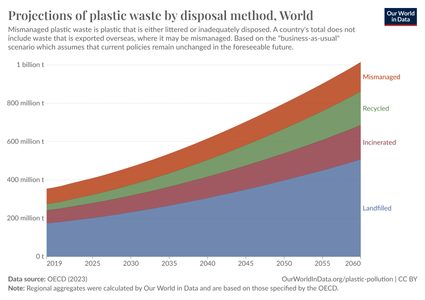
Despite the well-known environmental impact of single-use and short-lived plastics and the fact that their production could easily be prevented, industries continue to produce more of them. By 2025, single-use production is predicted to increase by at least 30%, reaching 70 million tons of plastic. That is a lot, right?
Impact of plastic on the environment and human health
Despite the overwhelming presence of plastic in our daily lives, we know surprisingly little about its impact on the environment and our health. However, what little we know is already enough to ring the alarm bells about these substances. Below, we will dive a little bit deeper into the effects of each of these types of substances, including the macroplastics, and explore their implications.
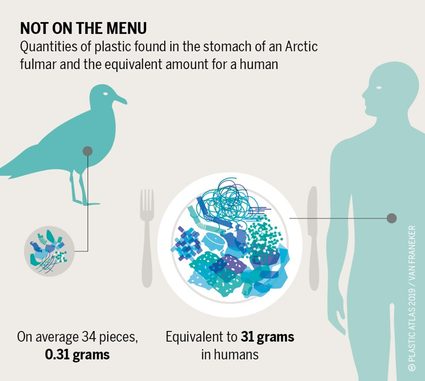
Macroplastics
These are plastics in their full shape, as we usually think of them. Think of the plastic cups, straws, and bottle caps we typically find on the beaches. Ever since we started producing plastic, the effects of littering have been relatively well-known.
-
Animals such as seagulls, turtles, and whales often mistake plastic for food, ingesting it and ultimately dying as a result.
-
They can also become entangled, tied, or trapped in plastic, leading to injuries or death.
-
The simple presence of plastic in the environment disrupts wildlife habitats, making it difficult for animals to live or breed as they usually would.
Micro- and nanoplastics (MNPs)
These include all the plastic particles that are 5 mm or smaller in size. Particles that are >10 µm are called microplastic, whereas those that are <10 µm are called nanoplastics. You can find these particles nearly everywhere you look. Humans are exposed to it through either direct skin contact, inhalation, or ingestion.
-
It is estimated that, on average, an individual will ingest around 0.1 to 5 g of MNPs per week and inhale between 26 and 170 airborne MNPs per day.
-
The presence of these particles within the human gut, blood, lungs, and placenta has been associated with an array of different conditions, from inflammatory bowel disease to cardiovascular complications.
-
Apart from directly affecting the body, MNPs can also act as vectors, transporting toxins and pathogens, such as different types of bacteria, into our bodies.
Plastic additives
Plastic additives comprise all the different substances added to plastics to change their characteristics, such as flexibility, durability, flammability, and even color. Just like MNPs, these chemicals are present all around us and can enter our bodies by either direct contact, inhalation, or ingestion, sometimes even with the help of the MNPs.
-
Some of the scientifically proven health effects that these substances have include cancer and the interference of the endocrine system, which can lead to reproductive, growth, and cognitive impairments.
-
The most well-known and dangerous plastic additives include phthalates, bisphenols, and per- and poly-fluoroalkyl substances (PFAS), which you can commonly find in everyday objects such as food packaging, bottles, and personal care products.
-
According to a recent , from the 16,324 known plastic chemicals, 10,726 still lack hazard data, meaning their toxicity remains unknown. That is a lot of chemicals to be exposed to without any toxicity knowledge or consent!
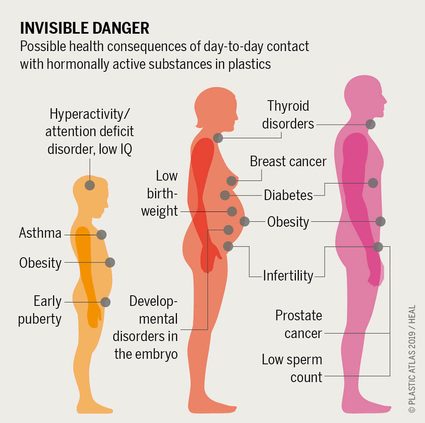
How to use the Reduce Your Plastic Calculator
The goal of the Reduce Your Plastic Calculator is to help you reduce your plastic consumption. Here is how it works!
-
Select the types of plastic you are currently using in your everyday life. The calculator provides 4 main categories: Food and kitchen, bathroom and laundry, containers and packaging, and others. Let's find out our plastic bag footprint.
-
Input your current use of plastic bag in the
Currentbox. Let's say that we use 6 plastic bags each week. Input6 / week. -
Input your goal to reduce your use of plastic bag in the
Goalbox. We can assume that we plan to shift to some reusable shopping bags, and we will only need 2 plastic bags per week.2 / week. -
That's all you need to do! Our reduce your plastic calculator will provide your overall plastic footprint, environmental impact, and how much beneficial impact you can make if you stick to your plastic reduction goal. Here, if you reduce your plastic bag use from 6 to 2 bags per week:
-
Your plastic footprint🥤 will be reduced to 0.8 kg of plastic per year and 63 kg of plastic in your lifetime!
-
Your CO2 footprint💭 will be reduced from 9 kg CO2/year to 3 kg CO2/year.
-
Your energy footprint⚡ will be reduced from 37 MJ/year to 12 MJ/year.
-
You will save animal lives 🐋! Up to 34 animals can stay alive because of your plastic reduction.
-
It is that simple to plan your contribution to a world with less plastic pollution 🌎.
Tips to reduce your plastic footprint
Reducing plastic consumption is essential to minimizing environmental impact and promoting sustainable living. Here are some practical tips to help you reduce plastic use:
-
Opt for reusable alternatives:
-
Use sturdy, reusable shopping bags made from cloth or other durable materials instead of single-use plastic bags. Our bag footprint calculator will help you pick the right bag for the job!
-
Replace disposable plastic water bottles with reusable stainless steel or glass bottles. This will benefit your health and the environment.
-
-
Be mindful of product packaging:
-
Choose products with minimal or no plastic packaging.
-
Buy loose fruits and vegetables instead of pre-packaged ones.
-
Select items packaged in paper, glass, or metal, which are more easily recyclable.
-
Utilize bulk buying options and bring your containers for grains, nuts, and cleaning supplies.
-
-
Switch to sustainable household items:
-
Replace plastic food storage containers with glass or stainless steel options.
-
Use beeswax wraps instead of plastic wrap to preserve food.
-
Choose bar soap and shampoo bars over liquid versions in plastic bottles.
-
Opt for biodegradable or compostable alternatives for toothbrushes, razors, and kitchen sponges.
-
-
Advocate for change in your community:
-
Participate in local clean-up events.
-
Educate others about the importance of reducing plastic consumption.
-
Support businesses and organizations that prioritize sustainable practices.
-
Encourage and support policies aimed at reducing plastic waste.
-
By making conscious choices and encouraging others to do the same, you can contribute to a larger movement to reduce plastic pollution and protect the environment.
💡 There are footprints from every action we do in our everyday lives. If you are curious to know more about how your day-to-day life activities have an impact on the environment, have a peek at these environmental footprint calculators by Omni Calculator:
Campaigns and organizations you can support
Reducing your own plastic consumption is a great start, but it is only the beginning of the journey. For real change, we must push governments and companies to adopt sustainable practices throughout plastic’s entire life cycle. After all, it is very difficult to reduce your own consumption when most, if not all, of the products you have access to are mostly plastic-made.
With this in mind, this section of the Reduce Your Plastic Calculator is dedicated to cool campaigns and resources that may help you continue your journey toward a plastic-free world. Enjoy!
-
The , a plastic footprint calculator for companies.
-
, by The Story of Stuff Project.
-
, by the coalition of North American zoos and aquariums.
-
, to learn more about plastic pollution and how to take action with solutions.
How long does it take for plastic to decompose?
Plastic takes hundreds to thousands of years to decompose, but it never entirely disappears; instead, it breaks down into micro- and nanoplastics that persist in the environment indefinitely. These tiny plastic particles continue to pose significant ecological and health risks as they accumulate in ecosystems and organisms.
What is recycling bias?
Recycling bias is the tendency for people to prioritize recycling over more effective waste management strategies like source reduction. This bias leads to underestimating the importance of producing less waste in the first place.
How do I calculate my plastic footprint?
To calculate your plastic footprint or the amount of plastic you generate over time, follow these simple steps:
-
Notice your plastic use: what type of plastic do you use, and how much over a specific period of time? For example, three single-use PET bottles per week.
-
Multiply the amount by its approximated weight. A PET bottle weights around 25 grams:
3 × 0.025 kg = 0.075 kg/week
-
Calculate the total footprint over time. Multiply the footprint per week to 52 for your yearly plastic footprint (or by 12 if your unit is per month):
0.075 × 52 = 3.9 kg/year
-
That's it! Now that you know your plastic footprint, you can plan your plastic use using our Reduce Your Plastic Calculator!